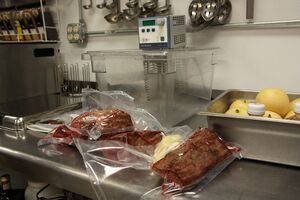Sous vide cooking
-
Beef Tenderloin vacuum packed and ready to be cooked sous vide.
-
Sous Vide Rib-eye Steak cooked for 4 hours at 120°F / 50°C. (seared separately).
-
Domestic sous vide cooker: SousVide Supreme
Sous-vide, French for "under vacuum", is a method of cooking food sealed in airtight plastic bags in a water bath for a long time—72 hours is not unusual—at an accurately determined temperature much lower than normally used for cooking, typically around 60 °C or 140 °F. The intention is to maintain the integrity of ingredients.
Principals
The primary feature of sous-vide is the use of temperatures much lower than for conventional cooking. The exclusion of air is secondary; it has the purposes of allowing cooked food to be stored, still sealed and refrigerated, for considerable times, useful for the catering industry but less so for domestic use; and to exclude oxygen from food that requires long cooking and is susceptible to oxidation, e.g., fat on meat which may become rancid with prolonged exposure to air.
Current proponents
The sous-vide method is used in several gourmet restaurants under Heston Blumenthal, Paul Bocuse, Michael Carlson, Thomas Keller, Ferran Adrià, Joël Robuchon, Alessandro Stratta, Charlie Trotter, and others.
Sous vide at home
Because of the high cost of sous vide cooking equipment, sous vide cooking was out of reach of most non-professional cooks. this is beginning to change as reasonably priced sous vide cookers are beginning to appear on the domestic market.
Time required
Cooking time is often not at always critical, within limits, as the temperature is not high enough to change the nature of the food rapidly. For example fish, which becomes dry very quickly if cooked conventionally for a little longer than necessary, will remain in perfect condition for a significant time.
Safety
Clostridium botulinum bacteria can grow in food in the absence of oxygen and produce the deadly botulinum toxin, so sous-vide cooking must be performed under carefully controlled conditions to avoid botulism poisoning. Generally speaking, food that is heated and served within four hours is considered safe, but meat that is cooked for longer to tenderise it must reach a temperature of at least 131 °F (55 °C) within four hours and then be kept there, in order to pasteurise the meat. Pasteurisation kills the botulism bacteria, but the possibility of hardy botulism spores surviving and reactivating once cool remains a concern as with many preserved foods, however processed.
Extra precautions need to be taken for food to be eaten by people with compromised immunity. Pregnant women may choose to be more careful than usual.
Vacuum packing foods with lots of sauce
When sous vide cooking meat, one often need to add a marinade or sauce to impart good flavour but vacuum sealing anything containing liquids can be a huge problem. I've found a solution for this which works with the Andrew James Professional Quality Vacuum Food Sealer Machine and probably most others. You might need a spare pair of hands to ensure it doesn't all end up on the floor but basically make sure the bag is large enough to contain the food and sauce with plenty of spare room to allow you to seal without a struggle. Set the bag as you would normally for vacuum sealing and hang the vacuum bag vertically over the worktop. Press the vacuum seal button and get ready to press the cancel button. Watch the bag carefully and the moment the sauce appears to move up to the edge of the bag, press the cancel button. Press the seal only button to seal the bag. That's all you need to do. It's not vacuum sealed per se, but it's absolutely fine for sous vide cooking.
DIY sous vide cooker
I built a very successful sous vide bath from a slow cooker. I worked perfectly for more than a year. Then I dropped the crock-pot.
Find recipes that contain 'Sous vide cooking'
See also
- Sous vide cooking
- Category:Sous vide recipes
- Sous vide cooking times
- How to cook sous vide meat to different levels of doneness
- Safe minimum cooking temperatures
- SousVide Supreme sous vide cooker
- Anova Standalone sous-vide water heater and circulator
- Home made sous-vide slow cooker conversion kit
- Vacuum sealer (generic)
- Andrew James Professional Quality Vacuum Food Sealer Machine
- Vacuum sealed containers
- Andrew James 8.5 Litre Professional Sous Vide Water Bath Cooker
- Burton Sous Vide Water Bath
- Can the Crockpot Slow cooker and Multi cooker be used as a sous vide bath?
#sousvidecooking #andrewjamesprofessionalqualityvacuumfoodsealermachine #fat #sousvidecooker #moleculargastronomytools #refrigerated #cookingmethods #sousvidesupreme #moleculargastronomy #moleculargastronomycookingmethods


